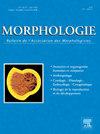Histological study of the capsular and discal insertions of the lateral pterygoid muscle
Q3 Medicine
引用次数: 0
Abstract
Many variations of the lateral pterygoid muscle (LPM) anatomy have been described and, because of its assumed insertions on the intra-articular disc, the muscle is supposed to pull it during mouth movements. In clinics, the LPM has been held responsible for some temporomandibular joint (TMJ) internal derangement. The aim of this study was therefore to verify the insertions of the LPM onto the disc and joint capsule, using macro-anatomical dissection of human material and histological analysis under the microscope. The results showed great variability in the measurements (percentage coefficient of variation: 25 < CV% < 82). No correlation could be found between the different parameters measured (Spearman correlation coefficient: 0.17 < rho < 0.61), nor any significant difference between the parameters measured on the left and right TMJs of the same specimen. Scarcity and small thickness of LPM fibers attaching directly onto the intra-articular disc raises doubts about its ability to mobilize it. The authors estimated that it would be useful to improve the anatomical knowledge of the muscle in order to better understand its action on TMJ, the behavior of the disc and for the purpose of future tri-dimensional (3D) biomechanical study.
翼状外侧肌囊盘嵌点的组织学研究
翼状外侧肌(LPM)解剖结构的许多变化已经被描述过,并且由于其假定插入关节内椎间盘,肌肉应该在口腔运动时拉动它。在临床上,LPM被认为是一些颞下颌关节(TMJ)内部紊乱的原因。因此,本研究的目的是通过对人体材料的宏观解剖和显微镜下的组织学分析来验证LPM对椎间盘和关节囊的插入。结果显示测量结果有很大的变异性(百分比变异系数:25 <;CV % & lt;82)。不同测量参数间无相关性(Spearman相关系数:0.17 <;ρ& lt;0.61),在同一标本的左右颞下颌关节上测量的参数无显著差异。直接附着在关节内椎间盘上的LPM纤维缺乏且厚度小,这使人们怀疑其动员关节内椎间盘的能力。作者估计,这将有助于提高肌肉的解剖学知识,以便更好地了解其对TMJ的作用,椎间盘的行为以及未来三维(3D)生物力学研究的目的。
本文章由计算机程序翻译,如有差异,请以英文原文为准。
求助全文
约1分钟内获得全文
求助全文
来源期刊

Morphologie
Medicine-Anatomy
CiteScore
2.30
自引率
0.00%
发文量
150
审稿时长
25 days
期刊介绍:
Morphologie est une revue universitaire avec une ouverture médicale qui sa adresse aux enseignants, aux étudiants, aux chercheurs et aux cliniciens en anatomie et en morphologie. Vous y trouverez les développements les plus actuels de votre spécialité, en France comme a international. Le objectif de Morphologie est d?offrir des lectures privilégiées sous forme de revues générales, d?articles originaux, de mises au point didactiques et de revues de la littérature, qui permettront notamment aux enseignants de optimiser leurs cours et aux spécialistes d?enrichir leurs connaissances.
 求助内容:
求助内容: 应助结果提醒方式:
应助结果提醒方式:


